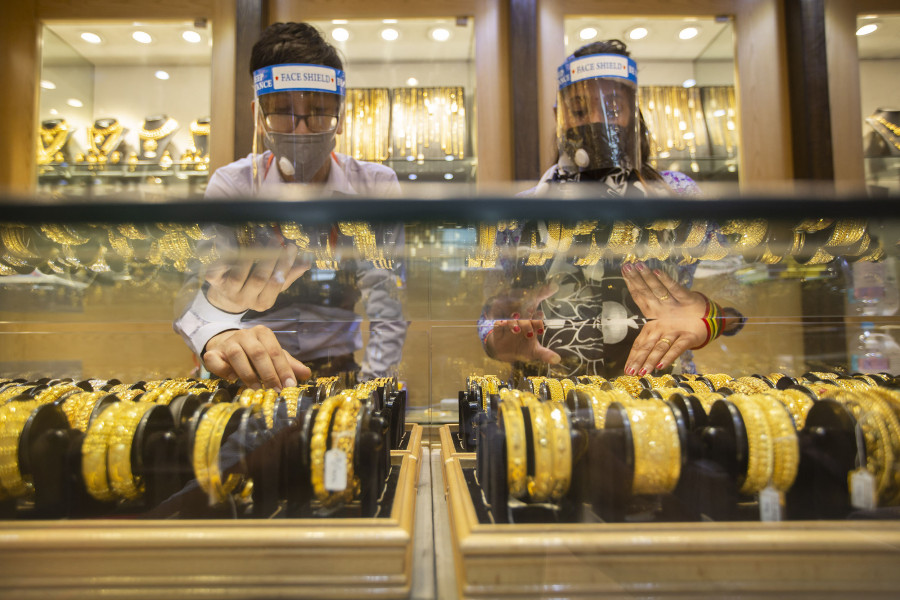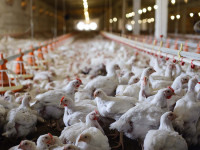Money
Gold import down by 60 percent in last fiscal year
Despite price per tola at nearly six-figure mark, demand among investors rose and banks sold 105 kg in just one week after lockdown was lifted in July.
Krishana Prasain
Much like the import of other non-essential commodities the import of gold also declined sharply in the fiscal year 2019-20 with 60.6 percent less of it entering the country compared to the fiscal year 2018-19 mainly because of the fall in demand.
According to Nepal Rastra Bank, the country imported Rs13.63 billion worth of the yellow metal in the last fiscal year, down from Rs34.63 billion compared to the previous one. The import had stood at Rs32.20 billion in the fiscal year 2017-18.
Of the country’s total imports the share of gold was 1.1 percent in 2019-20.
Tej Ratna Shakya, former president of Federation of Nepal Gold and Silver Dealers’ Association said gold was imported only five months in the last fiscal year.
With price increasing from Rs60,000 to Rs70,000 per tola (11.66 gram) in mid-June 2019 there were no imports between mid-July to mid-October in 2019 due to a fall in demand, he said.
“But as people started getting used to the new price and demand increased steadily, import began in mid-October and went on until March. Then with the nationwide lockdown, imports came to a halt,” Shakya said.
While the price of gold per tola is hovering around the six-figure mark at present, prices have been on an upward trend since June last year, leading people to sell their gold which resulted in sales decreasing drastically.
Last year, the prices continued to rise in the international market mainly due to the trade conflict between the US and China and bullion traders found the precious yellow metal as a safe haven to invest.
“The banks have not imported gold since the lockdown including in the current fiscal year,” he told the Post.
Gunakar Bhatta, spokesperson of the central bank said that imports will reduce with the rise in price, reducing the demand in the domestic market and discourage buyers unless it is for occasions like a wedding when gold is generally required since it is considered a luxury item.
“The pandemic has impacted the income and living standards of the people and they are focused on buying essentials rather than spending on luxury. Unless the economy gets back to normal, I don’t think the gold demand will rise,” Bhatta told the Post.
The dollar also became more expensive in the last fiscal year and this coupled with the continuous increase of bullion prices in the international market led to the decline in import.
“The decline in remittance is also an indirect reason for the fall in demand in the last fiscal year,” he added.
Lately, the price has reached previously unimaginable levels due to the economic uncertainty caused by the Covid-19 pandemic as investors around the world have poured their money into the precious metal with the fall in demand for oil and stock prices plunging.
In Nepal, the price of the yellow metal reached six-figure at Rs101,400 per tola on August 5, breaking all the records for the first time and went up as high as Rs103,500 per tola, the highest record in the history of the bullion market, before slightly falling.
Similarly, the government raised the import duty on gold by Rs2,000 per gram to Rs8,500 in the budget for the fiscal year 2020-21.
Its price has been fluctuating by $50 to 60 per ounce (28.34 gram) every day in the international market, according to Shakya.
But despite the rise in price, banks have been selling gold in substantial amounts after the lockdown was lifted on July 21.
According to Anil Sharma, executive director of Nepal Bankers’ Association, after the lockdown was eased, 105 kg of gold was sold within a week.
“People might have purchased gold considering it as a safe haven for investment with a slowing down of the economy and seeing the continuous rise in price in the international market despite the hike in price,” he said.
Commercial banks have 180 kg of gold in stock now. They are planning to import gold as soon as the restriction orders are lifted or eased as the available stock is getting low, Sharma told the Post.
Banks, who sell to gold dealers, used to import 600 to 650 kg of gold monthly before the lockdown, he said.
While banks were allowed to import 20 kg of gold daily earlier, the government reduced the quota to 10 kg daily with foreign reserves dwindling.
According to Shakya, the domestic bullion market used to have transactions of nearly around Rs60 billion annually but now it has gone down by as much as Rs20-22 billion during the lockdown, he said.
With the uncertain situation, he expects the bullion market will shrink for domestic use despite festivals like Dashain and Tihar as well as the wedding season approaching, Shakya added.
Bhatta said that around Rs30 billion has been saved from going outside while importing gold.
Nepal imports gold mainly from Dubai and Switzerland while gold comes from Turkey and Malaysia as well, according to Nepal Bankers’ Association.




 12.12°C Kathmandu
12.12°C Kathmandu













%20(1).jpg&w=300&height=200)
